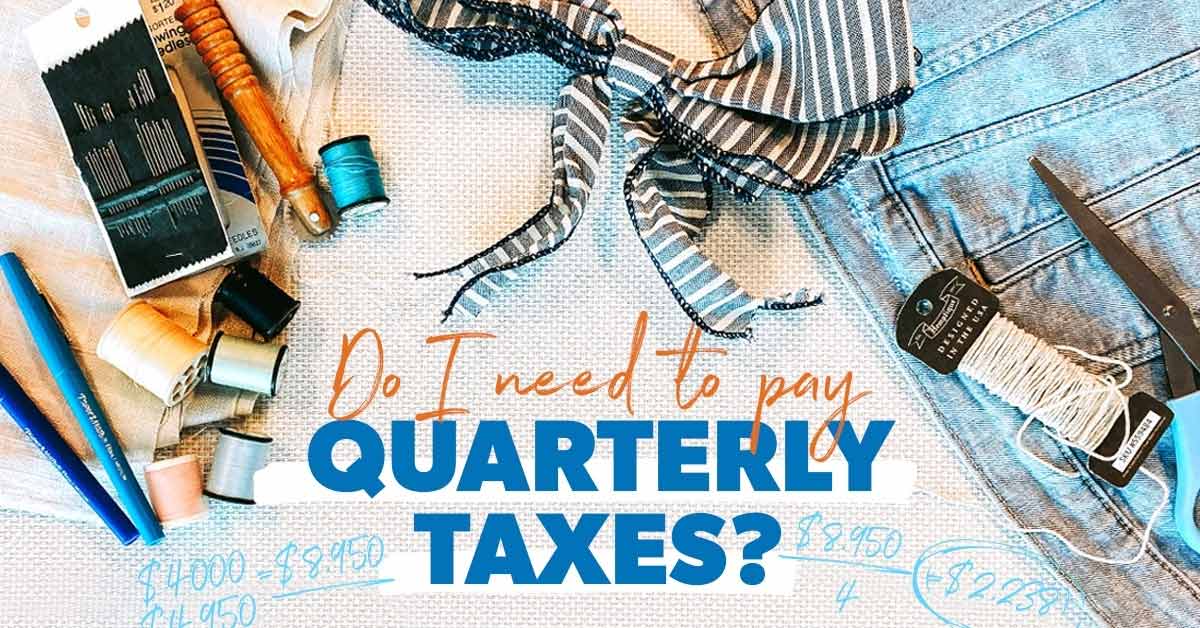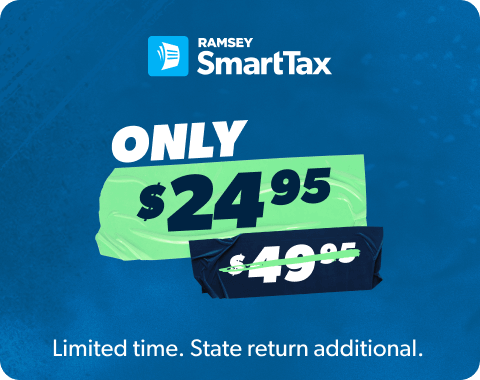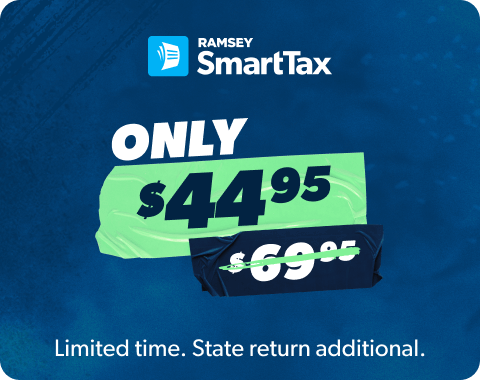
Key Takeaways
- Instead of having taxes withheld from their paycheck, self-employed individuals are responsible for paying their own taxes directly to the IRS through estimated tax payments, which are paid quarterly.
- Freelancers, independent contractors and small-business owners who expect to owe at least $1,000 in taxes from self-employed income must make estimated payments four times a year.1
- Quarterly taxes are calculated by figuring out how much you’ll owe in income tax and self-employment tax for the year and then dividing that amount into four payments. Adjustments can be made each quarter to reflect income changes. A good tax pro can help you make sure you do this right.
Fun fact: We don’t really “pay” our taxes on April 15 every year. In fact, by Tax Day, most U.S. workers have already had enough cash withheld from their paychecks throughout the year to cover taxes. A tax return simply lets the IRS know whether you’ve overpaid or underpaid.
But what if you’re self-employed and you don’t have an employer to withhold your taxes? Well, now it’s your responsibility to pay the IRS directly (ah yes—the joys of being your own boss). If you earn a certain amount, you’ll have to pay quarterly or estimated taxes four times a year.
This is where things can get a bit complicated, but it’s nothing you can’t handle—so don’t sweat it! We’ll walk you through how to calculate and pay your quarterly taxes on time so you can avoid pesky penalties and fees.
Let’s do it.
What Exactly Are Quarterly Taxes?
Depending on how much self-employed income you earn, you could have not one, but four “Tax Days” during the year. Bummer.
Quarterly taxes are divided into two categories:
- Self-employment tax: This 15.3% tax is made up of both the employee and employer portions of the Medicare and Social Security taxes.2 When you’re a salaried employee, your employer will split the cost of those taxes with you. But when you’re in business for yourself, you’re responsible for the whole thing.
- Income tax: You’ll pay taxes on your income at your income tax rate, just like everyone else.
Your tax bill can add up pretty quickly, so you should set aside 25–30% of every paycheck for taxes if you’re self-employed. You don’t want to get blindsided by a huge tax bill. Ever seen a quarterback looking to pass and then getting crushed by a lineman? That’s what a surprise tax bill feels like.
Who Pays Quarterly Taxes?
Freelancers, independent contractors and small-business owners who expect to owe at least $1,000 in taxes from their self-employed income are required by the IRS to make estimated tax payments.3
If you owe less than $1,000, you can just pay your taxes on that income when you file your tax return at the end of the year.
Important: It doesn’t take long to rack up a $1,000 tax bill, so even a side hustle could complicate your tax situation. If you have a regular job and don’t want to mess with quarterly payments, you can increase your withholding at your job to offset taxes earned from your side hustle.
Reach out to a tax professional if you need help figuring out whether or not you’ll need to pay quarterly taxes. If you wind up owing a significant amount of taxes and didn’t pay quarterly, you may have to pay an underpayment penalty on top of the taxes you owe. So don’t overlook this!
When Are Quarterly Taxes Due?
If you’re one of the many Americans who need to file quarterly, circle these deadlines on your calendar or set reminders on your phone so you don’t forget to pay on time! Being late on a payment means you’ll be hit with interest and late payment penalties each month that could go as high as 25% of your unpaid taxes.4
Got small business tax questions? RamseyTrusted tax pros are an extension of your business.
Quarterly deadlines are April 15, June 15, September 15 and January 15 unless those days fall on a weekend or holiday. Then the deadline moves to the next business day.5
Here are the quarterly tax deadlines for income you earn in 2025:
|
When You Get Paid |
Tax Due Date |
|
Jan. 1–March 31 |
April 15, 2025 |
|
April 1–May 31 |
June 16, 2025 |
|
June 1–Aug. 31 |
Sept. 15, 2025 |
|
Sept. 1–Dec. 31 |
Jan. 15, 2026 |
Looking ahead, here are the quarterly tax deadlines for income earned in 2026:
|
When You Get Paid |
Tax Due Date |
|
Jan. 1–March 31 |
April 15, 2026 |
|
April 1–May 31 |
June 15, 2026 |
|
June 1–Aug. 31 |
Sept. 15, 2026 |
|
Sept. 1–Dec. 31 |
Jan. 15, 2027 |
How Do I Figure Out How Much I Owe in Quarterly Taxes?
All righty, it’s time to dust off your calculator and crunch some numbers! Here’s a step-by-step process to help you figure out how much you’ll need to pay in estimated quarterly taxes.
Remember, this is just an estimate. Depending on your income, the tax year, your filing status and eligible deductions, your quarterly taxes will vary. And don’t get us started on state income taxes!
Let’s say you’re filing single and have a small business. With that small business, you’re expecting your gross self-employment income will be around $75,000 in 2025. You’re anticipating having around $25,000 in business expenses, which brings your net self-employed income to $50,000.
Step 1: Calculate your self-employment tax.
First, let’s calculate the self-employment tax, which covers the Social Security and Medicare taxes you owe.
As a self-employed person, you're responsible for both the employee and employer portions, which is why the self-employment tax rate is 15.3% (12.4% for Social Security and 2.9% for Medicare). But you only pay self-employment tax on 92.35% of your net earnings.6
So in this case, you’ll take your net self-employed income ($50,000) and multiply it by 92.35% to get the amount that’s subject to self-employment tax. Then, you just multiply that number by the 15.3% tax rate and, voila, you have your self-employment tax for the year:
($50,000 x 92.35%) 15.3% = $7,065 self-employment tax owed
It’s also important to remember that half of the self-employment tax is deductible from your income tax calculations—which is why we calculate the self-employment tax first.
Step 2: Figure out your taxable income.
Yup, your self-employed income is also subject to federal income tax like everyone else’s (bummer). But before we can figure out how much you owe in income tax, you'll need to find your taxable income, which is the portion of your income that’s actually subject to federal income tax.
Your taxable income is basically your gross self-employed income minus all your tax deductions—that includes your deductible business expenses, the deductible portion of your self-employment tax, and either the standard deduction or itemized deductions.
Gross Income ($75,000) - Business Expenses ($25,000) - Self-Employment Tax Deduction ($3,533) - Standard Deduction ($15,000) = Taxable Income ($31,467)
Once you’ve figured out your taxable income, we can go ahead and calculate what you’ll likely owe in income taxes in 2025.
Step 3: Estimate your income tax.
Since you’re filing single and your taxable income will be $31,467 in 2025, that puts you in the 12% tax bracket.7 That means your income up to $11,925 is taxed at 10%, and your income between $11,925 and $31,467 is taxed at 12%.
Once you’ve crunched the numbers, we see you’re likely to owe about $3,538 in income tax for the year.
Step 4: Add up your income tax and self-employment tax for the year.
Add your income tax and self-employment tax together and you’ll get your estimated taxes for the year. In this case, your total estimated tax bill for the year is $10,603.
Income Tax ($3,538) + Self-Employment Tax ($7,065) = Estimated Annual Taxes ($10,603)
Step 5: Divide your estimated annual taxes into quarterly payments.
Since you owe more than $1,000 in taxes, the estimated annual tax is what you’re going to base your quarterly taxes on. All you have to do is divide that total amount into four quarterly payments you’ll make to the IRS. In this case, each payment would be around $2,651.
$10,603 ÷ 4 = $2,651
Step 6: Send an estimated quarterly tax payment to the IRS.
Now that you’ve figured out your quarterly tax payment, all you have to do is pay Uncle Sam! You can pay your quarterly taxes several ways:
- Pay online. You can go to the IRS payment page and set up online payments for your taxes using a bank account or a debit card.8
- Pay by phone. You can enroll for free in the Electronic Federal Tax Payment System (EFTPS) and use their voice response system to pay your taxes over the phone.9
- Pay by app. This is the 21st century, so now you can pay your taxes through the IRS2Go app right on your phone or tablet.10 What a time to be alive!
- Pay by cash or check. You can go really old-school and pay in person at your local IRS office or mail in a check or money order.11
There are a couple more things to remember. First, the taxes above are just an estimate. You still need to file a tax return by Tax Day to show what you actually earned during the year. This is also when you can claim credits and deductions that lower your tax bill.
And second, if you see that your income is going to be higher or lower than you thought it would be, you can always adjust your estimated taxes each quarter.
Make Sure You Stay on Track
Trust us—the last thing you want is a big fat tax bill in April, packed with late fees and penalties, just because you skipped out on your quarterly payments. If you’re self-employed and required to pay quarterly taxes, mark your calendar, crunch the numbers, and make your payments on time.
Your future self will thank you.
Next Steps
- Still need to get your stuff together for tax season? We’ve got you covered with our free self-employed tax checklist, which can help you get everything you need in order.
- If you’re not sure what actually counts as a tax write-off when it comes to running your own business or side hustle, you’re not alone. Our article 23 Common Tax Deductions for Small-Business Owners can help you make sure you’re not missing a single tax break!
- Still have questions about quarterly payments? RamseyTrusted® tax pros can help you take the stress out of tax season so you can get back to doing the work you love most.
- If your taxes are simple enough to do on your own and you want an easy-to-use tax software that can give you some peace of mind, check out Ramsey SmartTax! No hidden fees, no advertisements, no games. That’s how it should be!
Federal Classic Includes:
-
All major income types and federal forms
-
Prepare, print and e-file
-
Phone and email support
-
1 year of audit assistance
Federal Premium Includes:
Everything in Federal Classic plus:
-
Live chat
-
Priority phone and email help
-
Free financial coaching session
-
3 years of audit assistance
-
1 month of ID theft protection




